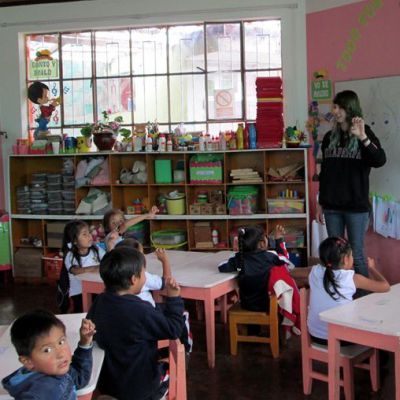Adding Love to the Crayon Box
During service, for at least one journal entry students pursued experiential learning through a strategy called action-reflection-response. The idea is to learn from daily life by noticing something that you don’t understand, gathering more information and responding by changing your behavior or attitude.
Lydia worked each morning at Jardín de Ninos Los Jazmines (Jasmine) preschool and kindergarten in Oxapampa, a town in the high jungle. Here is Lydia’s journal entry based on the action-reflection-response strategy.

Step one. I’ve been quite frustrated with one boy who always seems to act up in class. He’s always fighting with the other students, and never paying attention or doing his work.
Step. 2. In class this boy was pulling a girl’s ponytail and then ran to the other side of the room to bother another boy by stealing the crayon he was using to color. I approached the troublemaker and told him he needed to stop bothering the others, go sit down and do his work.
I placed my hands on his shoulders to guide him to his seat. He then reached around and dug his hands into my wrist with his nails. I twisted out of his grip and held onto his hands and scolded him, saying he needs to not hurt people. He pulled back his hands, punched my waist a couple of times and ran off.
Step 3. The professor saw my attempts to calm him. When I looked over at her for guidance, she shook her head and said, “Horrible, no?” I asked her if there was a reason the boy acted the way he did. Her demeanor changed to sympathetic and she said, “El no tiene una mama. Su padre. . . “ ( “He doesn’t have a mother. His father . . .” ) and she made a drinking gesture, and said, “mucho.”
“Ah,” I said, in understanding. She also said that in addition to drinking heavily, the father punishes the boy by hitting him. It must be bad (that is, a well-known fact), if his professor knows about it.
Step 4. I went home and talked to my host mom about what I had learned. The words she said matched what I had been thinking. “Pobrecito. El necesita carinos y amor.” ( “Poor child. He needs care and love.”)
The next day, when it was time to enter the classroom with the boy, I had a plan. I greeted him and paid special attention to him. When all the others were coloring and he started acting up, I trapped him in a hug and said, “Let’s color together. Go get your colors.”
Something small changed in his face and he excitedly said, “Si,” and ran to get his box of colors. He came and sat on my lap, and we colored the chicken that everyone else was working on. It was the first day, since I had arrived, that he actually finished coloring a page. When he was done, he was so proud and showed it off to the other students and the professor. When I turned to the professor, she raised her eyebrows in amazement.
All he needs in his life is guidance and love, two things that seems to be missing. I hope to have the patience to continue to give him a bit of what I can offer.




